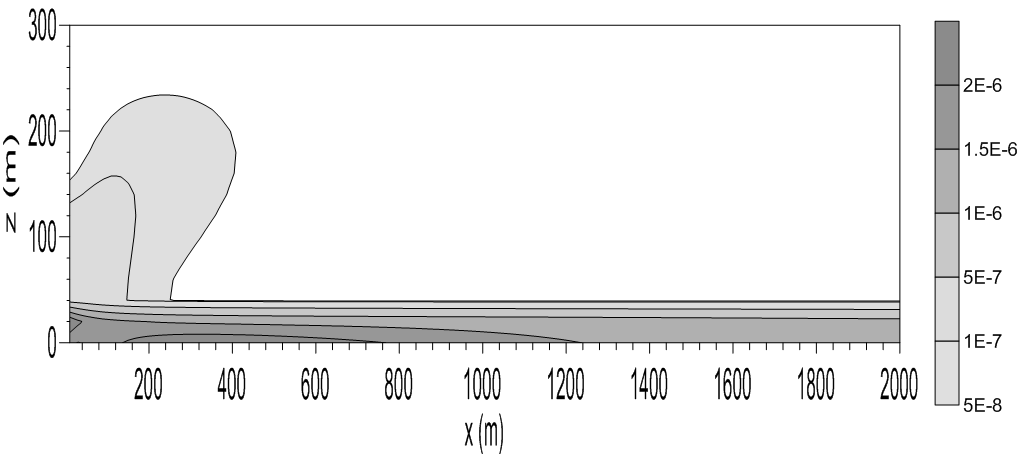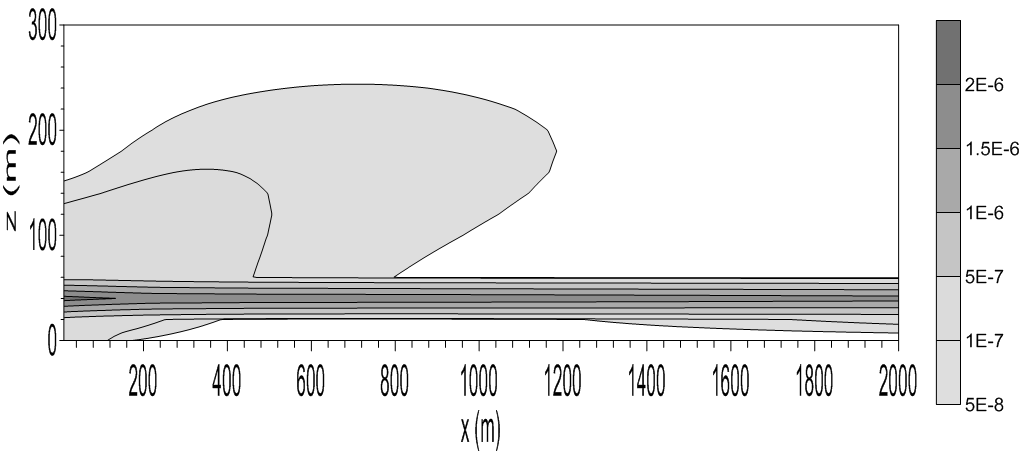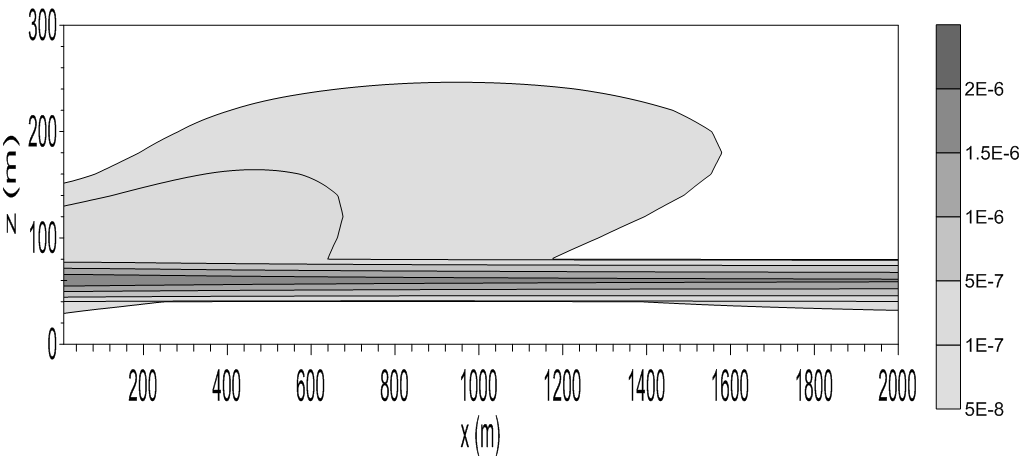-
Paper Information
- Next Paper
- Previous Paper
- Paper Submission
-
Journal Information
- About This Journal
- Editorial Board
- Current Issue
- Archive
- Author Guidelines
- Contact Us
American Journal of Environmental Engineering
p-ISSN: 2166-4633 e-ISSN: 2166-465X
2016; 6(4A): 40-45
doi:10.5923/s.ajee.201601.06

Pollutant Dispersion Simulation During Sunset Transition Time Using an Analytical Eulerian Model
Jéssica K. Reis, Jonas C. Carvalho, Daniela Buske, Regis S. Quadros
Pos-Graduate Program in Mathematical Modeling, Federal University of Pelotas, Pelotas, Brazil
Correspondence to: Jonas C. Carvalho, Pos-Graduate Program in Mathematical Modeling, Federal University of Pelotas, Pelotas, Brazil.
| Email: |  |
Copyright © 2016 Scientific & Academic Publishing. All Rights Reserved.
This work is licensed under the Creative Commons Attribution International License (CC BY).
http://creativecommons.org/licenses/by/4.0/

In this study an analytical Eulerian model is employed to simulate the pollutant concentrations released from continuous point source during the sunset transition period. The analysis applies the dispersion model parameterized by the stable and decaying convective eddy diffusivities, representing the turbulent mixing in the stable boundary layer and residual layer. The concentration simulations are calculated considering different times in the transition process through the sunset period. The results presented in this paper show similarity with ones reported in the literature, where the mixing strong action generated by the decaying convective energy-containing eddies in the RL causes an effective entrance of pollutants to the interior of the recently established SBL. During the initial stage of the transition period, in which the SBL presents a small depth, the combination between residual convective and stable eddies act efficiently to transport the pollutants in direction to the ground surface. For the later stages, the height of the SBL depth reaches the point source height so that the dispersion occurs in a large vertical extension that is dominated by stable turbulence. The lack of effective turbulent mixing, acting over the vertical extension of the SBL, prevents pollutants to reach the surface. In the present contribution focus is put on an analytical description of the pollutant dispersion occurring around the evening transition, which allows simulate the turbulent transport in a computationally efficient procedure.
Keywords: Planetary boundary-layer, Stable boundary layer, Residual layer, Pollutant dispersion, Eulerian modeling, Turbulent parameterization, Analytical solution
Cite this paper: Jéssica K. Reis, Jonas C. Carvalho, Daniela Buske, Regis S. Quadros, Pollutant Dispersion Simulation During Sunset Transition Time Using an Analytical Eulerian Model, American Journal of Environmental Engineering, Vol. 6 No. 4A, 2016, pp. 40-45. doi: 10.5923/s.ajee.201601.06.
Article Outline
1. Introduction
- About one hour before sunset over land, the surface heat flux becomes negative and, consequently, a stable boundary-layer (SBL) develops near the ground [12, 17]. Above this SBL, in the residual layer (RL), the convective eddies start to lose their strength and the convective boundary-layer (CBL) begins to decay. The dispersion of pollutants by turbulent flows is of central importance in a number of environmental problems, but less attention has been paid to the dispersion in the RL, where the diffusion of pollutants occurs in conditions of decaying convective turbulence. The decay of energy-containing eddies in the CBL is the physical mechanism that can sustain the dispersion process in the RL.Turbulence decay in the CBL has been studied by [12] using the dynamical equation for the energy density spectrum, by [5, 16, 17, 19, 20] employing LES models and by [9] employing a random displacement model. Experimental results has been reported by [1, 2, 10, 14, 15].In this paper is investigated the turbulent dispersion process occurring during the sunset transition, focusing the characteristic patterns of the turbulent dispersion of pollutants released from a continuous point source in a diffusive PBL characterized by a decaying convective one. This analysis considers an analytical solution of the advection-diffusion equation, in which the turbulent effects are represented by eddy diffusivities for a SBL proposed by [11] and for a decaying turbulence in the CBL proposed by [11]. The use of these convective decaying eddy diffusivities in air quality models will generate realistic turbulent patterns associated to the sunset transition time. The simulation procedure is realized according methodology presented in [9], which used the random displacement equation to examine the dispersion process of contaminants emitted from low and tall sources during sunset period.Thus, with these parameterizations (stable below and convective decaying turbulence aloft), the analytical Eulerian model can be used to evaluate the influence of the decaying convective eddies on the concentration field of pollutants released by elevated continuous point sources during the sunset transition time and the first hours of SBL development. The reason why adopting an analytical procedure instead of using the nowadays available computing power resides in the fact that once an analytical solution to a mathematical model is found one can claim that the problem has been solved. It is provided a closed form solution that may be tailored for numerical applications such as to reproduce the solution within a prescribed precision. As a consequence the error analysis reduces to model validation only, in comparison to numerical approaches where in general it is not straight forward to disentangle model errors from numerical ones [7].
2. Turbulence Parameterization
- The aim of this section to exhibit and discuss the eddy diffusivities that have been employed in the analytical model to simulate the concentration field of contaminants by an elevated continuous point source during the sunset transition time. So, it is necessary parameterize the turbulent transport in a shear-dominated stable PBL and the decaying convective elevated turbulent dispersion.
2.1. Parameterization of the Stable PBL
- The following relationships for longitudinal, lateral and vertical eddy diffusivities
 derived by [11], represent the turbulent diffusion in a shear-dominated stable PBL:
derived by [11], represent the turbulent diffusion in a shear-dominated stable PBL: | (1) |
 and
and  is the Obukhov length,
is the Obukhov length,  is the surface layer friction velocity and h is the height of the stable layer. The magnitudes of the
is the surface layer friction velocity and h is the height of the stable layer. The magnitudes of the  coefficients in the numerator of Eq. (1) show that the eddy vertical motion is strongly limited by the positive stratification.
coefficients in the numerator of Eq. (1) show that the eddy vertical motion is strongly limited by the positive stratification.2.2. Parameterization of the Residual Layer
- A general method to derive eddy diffusivities in a decaying turbulence in the CBL has been proposed by [13]. The method is based on a model for the budget equation describing the energy density spectrum and the Taylor statistical diffusion theory. The turbulent field has been considered isotropic to calculate the longitudinal and lateral eddy diffusivities and non-isotropic to derive the vertical eddy diffusivity. The following relationships represent fits to the decaying convective eddy diffusivities obtained from the model proposed by [13]:
 | (2a) |
 | (2b) |
 | (2c) |
 is the height of the mixing layer,
is the height of the mixing layer,  is the convective velocity scale and
is the convective velocity scale and 
3. Eulerian Modelling
- The Eulerian model considered here is represented by the advection-diffusion equation. We must recall that this equation is obtained combining the continuity equation ruled by the conservation law with the Fickian closure of turbulence. Indeed, we write the advection-diffusion equation in Cartesian geometry like [6]:
 | (3) |
 | (3a) |
 | (3b) |
 | (3c) |
 | (3d) |
 | (3e) |
 denotes the mean concentration of a passive contaminant,
denotes the mean concentration of a passive contaminant,  and
and  are the cartesian components of the mean wind in the directions x (0 < x < Lx), y (0 < y < Ly) and z (0 < z < h) and
are the cartesian components of the mean wind in the directions x (0 < x < Lx), y (0 < y < Ly) and z (0 < z < h) and  and
and  are the eddy diffusivities. Q is the emission rate, h the height of the atmospheric boundary layer, Hs the height of the source, Lx and Ly are the limits in the x and y-axis and far away from the source and
are the eddy diffusivities. Q is the emission rate, h the height of the atmospheric boundary layer, Hs the height of the source, Lx and Ly are the limits in the x and y-axis and far away from the source and  represents the Dirac delta function. The source position is at
represents the Dirac delta function. The source position is at  and z = Hs. Problem (3) is solved by the 3D-GILTT method [7, 8]. In the initial step it is expanded, without physical equivalence, the contaminant concentration in a series in terms of a set of orthogonal eigenfunctions. These eigenfunctions are the solution of a simpler but similar problem to the existing one. Replacing this expansion in the Eq. (3), the resulting problem reduces to a two-dimensional one already solved by the Laplace transform technique and GILTT method as shown in [15, 16]. For the simulations, the methodology presented by [15, 16] is considered. Here we assumed a Cartesian coordinate system in which the x direction coincides with the one of the predominant wind, the advection is much larger than the diffusion in the x-direction and the crosswind integration of the Eq. (3). The micrometeorological parameters
and z = Hs. Problem (3) is solved by the 3D-GILTT method [7, 8]. In the initial step it is expanded, without physical equivalence, the contaminant concentration in a series in terms of a set of orthogonal eigenfunctions. These eigenfunctions are the solution of a simpler but similar problem to the existing one. Replacing this expansion in the Eq. (3), the resulting problem reduces to a two-dimensional one already solved by the Laplace transform technique and GILTT method as shown in [15, 16]. For the simulations, the methodology presented by [15, 16] is considered. Here we assumed a Cartesian coordinate system in which the x direction coincides with the one of the predominant wind, the advection is much larger than the diffusion in the x-direction and the crosswind integration of the Eq. (3). The micrometeorological parameters 
 and
and  [16] were considered for generating the eddy diffusivity profiles during the simulation. The simulations started at the moment of sunset when the surface heat flux progressively decreases and a stable boundary-layer develops near the ground. Profiles of eddy diffusivities suggested by [11] were informed to the stable boundary layer and derived by [13] (Eqs. 1-3) were informed to the residual layer. The evolution of the PBL height was calculated according to the expression
[16] were considered for generating the eddy diffusivity profiles during the simulation. The simulations started at the moment of sunset when the surface heat flux progressively decreases and a stable boundary-layer develops near the ground. Profiles of eddy diffusivities suggested by [11] were informed to the stable boundary layer and derived by [13] (Eqs. 1-3) were informed to the residual layer. The evolution of the PBL height was calculated according to the expression  [2], where h is given in meters and
[2], where h is given in meters and  in hours. During the simulation, new profiles of eddy diffusivities and new values of SBL height were provided to the model in intervals according to Table 1.
in hours. During the simulation, new profiles of eddy diffusivities and new values of SBL height were provided to the model in intervals according to Table 1.
|
4. Results
- In this section is discussed the simulation results obtained with the Eulerian analytical model (Eq. 3) parameterized by the eddy diffusivities given by the Eqs. (1), (2a), (2b) and (2c). For the sunset transition period there will be analyzed the simulation of the cross-wind concentration field of contaminants released from a continuous point source at a height of 60m. The dispersion simulation is realized during the evolution time of the sunset transition according to Table 1.Fig. 1 exhibits dispersion effects for the initial time of 900s and height of the stable layer of 35m. Analyzing the diffusion pattern associated to this figure it can be seen that the contaminants released from the source directly into the RL suffer a strong mixing action. This intense level of dispersion associated to the decaying turbulence in the RL is responsible for the entrance of contaminants to the interior of the SBL. It is possible to notice also that the contaminants go through in the interior of the SBL and reach the ground next to the point source. The dispersion effect of the decaying convective eddies in the RL over the plume of contaminant, pushes it down toward the top of the SBL and is captured by this new environment containing different diffusion properties. Then, the plume of contaminants disperses under the action of shear-dominated stable turbulence in the interior of the SBL. The stable turbulence from mechanical origin, is generated by the surface wind shear and consequently the energy-containing eddies in this layer are in the proximity to the surface. For a continuous stable turbulence, sustained by the mechanical forcing, the turbulent vertical velocity variance decreases with the height and this variance asymmetry (vertical inhomogeneous turbulence), induces an acceleration (drift velocity) that transports the contaminants in the direction to the surface where the wind shear turbulence diffusion action is dominant. This transport downward, associated to the wind shear turbulence above discussed, is particularly dominant in SBLs that present a small depth. In this thin initial SBL the effects of surface turbulence generation influence the major part of the SBL vertical extension.
 | Figure 1. Cross-wind concentration field (x-z plane). Source height of 60 m and stable boundary layer height of 35 m. Concentration in g m-2 |
 | Figure 2. Cross-wind concentration field (x-z plane). Source height of 60 m and stable boundary layer height of 50 m. Concentration in g m-2 |
 | Figure 3. Cross-wind concentration field (x-z plane). Source height of 60 m and stable boundary layer height of 60 m. Concentration in g m-2 |
 | Figure 4. Cross-wind concentration field (x-z plane). Source height of 60 m and stable boundary layer height of 70 m. Concentration in g m-2 |
 | Figure 5. Cross-wind concentration field (x-z plane). Source height of 60 m and stable boundary layer height of 80 m. Concentration in g m-2 |
5. Conclusions
- In this study an analytical description was employed to simulate the pollutants concentration released from continuous point source during the sunset transition period. The analysis applied the dispersion model parameterized by the stable and decaying convective eddy diffusivities, representing the turbulent mixing in the SBL and RL. The concentration simulations were calculated considering different times in the transition process through the sunset period. The simulations analyzed the crosswind concentration field of contaminants released from a continuous point source at a height of 60m. The simulations showed that during the initial evolution times during the sunset transition, the turbulent diffusion generated by the decaying convective eddies in the RL caused an effective transference of contaminants to the interior of the SBL. During the initial stage, in which the SBL presents a small depth, the combination between residual convective and stable eddies acts efficiently to transport the pollutants in direction to the ground surface. Therefore, the present analysis showed that for this initial time, the combination between residual convective and stable eddies acts to transport the contaminants in direction to the ground, increasing the concentration at the surface.For the final phase of the sunset transition period the SBL height reached the point source height and the dispersion occurred in a stable environment. This condition generated a fanning plume shape, which is characterized by a large spread in the horizontal and vary little spread in the vertical direction. The results showed that the plume traveled for long distance and the maximum of the concentration remains in the same level of the emission source. As a consequence of this lack of an effective turbulent mixing, acting over the whole vertical extension of the SBL, the contaminants do not arrive at the surface.The results presented in this paper show similarity with ones reported in the literature, where the strong mixing action generated by the decaying convective energy-containing eddies in the RL causes an effective entrance of pollutants to the interior of the recently established SBL.
ACKNOWLEDGEMENTS
- The authors acknowledge the financial support provided by CNPq (Conselho Nacional de Desenvolvimento Científico e Tecnológico), CAPES (Coordenação de Aperfeiçoamento de Pessoal de Nível Superior) and FAPERGS (Fundação de Amparo à Pesquisa do Estado do Rio Grande do Sul).
 Abstract
Abstract Reference
Reference Full-Text PDF
Full-Text PDF Full-text HTML
Full-text HTML and SBL height according expression
and SBL height according expression 
